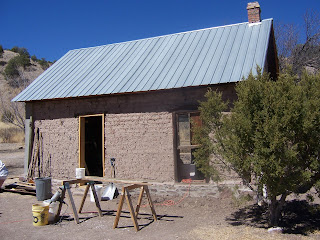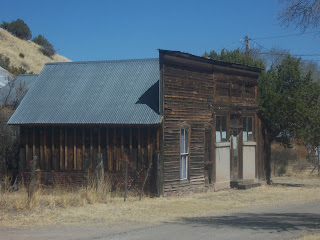Today is Jason's birthday. Happy Birthday, son. This picture was taken during a successful Wyoming hunting trip.
Shortly after leaving Elephant Butte for a day of exploring, we went by the T or C Municipal Airport. They have this Air Force plane on display by the entrance to the airport.
As we headed to the mountains, we passed through an area of large cattle ranches. We thought the spurs on these mail boxes were great.
There is a lot of open range areas in this part of NM. The red calf was behind a fence but he was curious about us taking a picture of him.
The first small town we saw as we drove on Hwy 52 toward the mountains was Cuchillo. It is now a small village with some farms and ranches. During the mining boom of the 1880's and 1890's, it was a stage stop used to deliver goods to the mining towns of Winston and Chloride. The San Jose Mission is the only maintained building left from that era.
We passed through this area of the Sierra Cuchillo mountain range, a part of the Black Range. There are lot of pinion (pinyon) pine trees. You could see forever.
The town of Winston was founded in the early 1880s by miners who found Chloride "too rowdy". The two towns are only several miles apart. Once named Fairview, its name was changed in honor of Frank H. Winston, a local miner, businessman and legislator. Today its a rundown rural community.
Just a reminder that these towns are in a remote area of New Mexico.
After a beautiful drive, we arrive at Chloride. It's a historic mining town that got its start in the late 1870's when muleskinner, Harry Pye, found silver while passing through the area when hauling freight for the army. The town was orginally known as Pyetown, then Bromide and then became Chloride after the type of silver that was mined in the area.
All the property in Chloride is now privately owned. Don and Dona Edmund have purchased many of the old buildings and have restored or are restoring them.This building was built as the Monte Cristo Saloon and Dance Hall as well as a schoolhouse and headquarters for various mining companies. It is now a gift shop and gallery featuring only local artists. The ceiling fan is the original fan.
The Grafton Cabin is a two-story log building moved to Chloride in 2005 as part of the museum. It was originally built in a mining camp called Grafton that was about 10 miles NW of Winston.
The restored cabin of Harry Pye. Pye had kept his secret of finding silver secret until his army contract expired. He returned with several other prospectors to stake a claim. Within a few months, the Pye party was attacked by Indians and Pye was killed.
Two necessities - an outhouse and a satellite dish.
Two of the buildings currently being restored. The adobe cabin was a miner's cabin. The stone building was originally built as a bank but failed before opening. Instead, it was opened as a saloon. It was the ninth saloon in Chloride.
The Pioneer Store Museum was originally opened in 1880 as a company store until it closed in 1897. In 1908, the building was bought by another mining company and used as a commissary for their crews. In 1923, the commissary went out of business. The owners boarded up the doors and windows leaving all the furniture and merchandise. Don and Dona have spent many years cleaning out the rat and bat droppings but nothing had been disturbed in almost 70 years. They have done an amazing job of displaying these collections and are the ultimate hosts and tour guides.
The museum is a treasure of artifacts from the era when Chloride was a booming mining town. We have included a slide show on our blog of all the pictures taken while we toured the museum.
Bill never worked behind bars but he did sort mail in separations similar to these.
Stories passed through generations call this the The Hanging Tree". However, no one can say for sure that anyone was actually hung from this tree. It's believed it was used to chain up drunks to get sober because it was too far to haul them to jail.
There are only 9 residents in this old mining town that was once a community of 3000 residents, 9 saloons, 3 general stores, 2 hotels, restaurants, boarding houses, assay offices, a stage line and a Chinese laundry.













































































